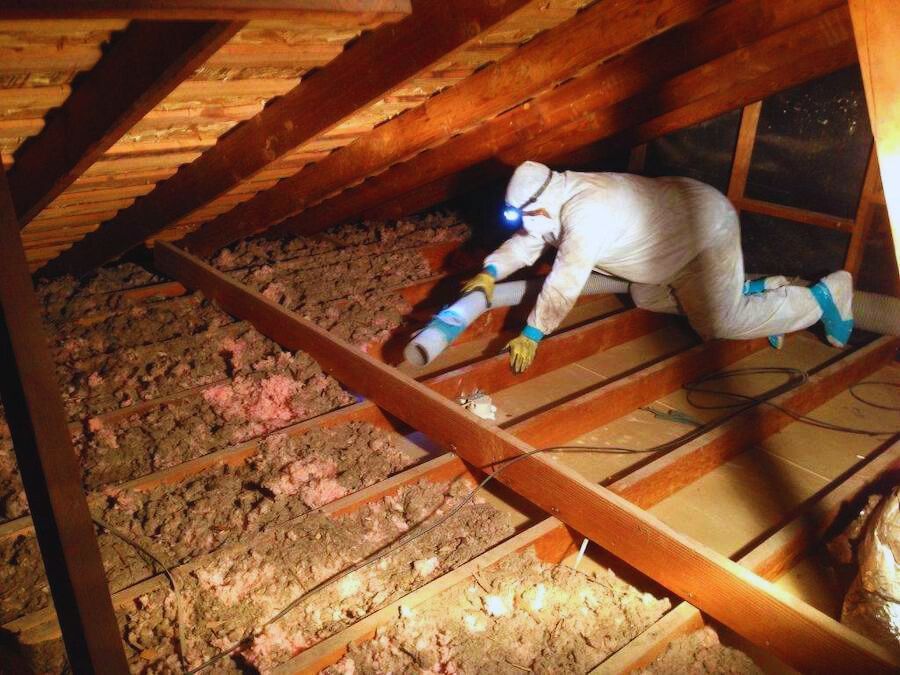Insulation Removal Service

FAQ: Removing Old Insulation When Installing Spray Foam Insulation
How much does it cost to remove old insulation?
The cost to remove old insulation can vary based on several factors, including the type of insulation being removed and the size of the space. On average, insulation removal costs between $1 to $2 per square foot. Additional costs may be incurred if the insulation is contaminated (e.g., with mold or pests) or if it is difficult to access, such as in tight attics or crawlspaces.
Is it necessary to remove old insulation before installing spray foam?
Yes, it is generally recommended to remove old insulation before installing spray foam insulation. Spray foam works best when applied directly to the surfaces that need to be insulated, such as attic rafters or wall cavities. Leaving old insulation in place can interfere with the spray foam’s ability to expand and properly seal air leaks. Additionally, old insulation may contain contaminants like mold, dust, or rodent droppings, which you wouldn’t want to trap underneath the spray foam.
What factors affect the cost of insulation removal?
Several factors can affect the cost of removing old insulation. The type of insulation plays a big role, as different materials—such as fiberglass batts, blown-in cellulose, or spray foam—require different removal methods. The size of the area is also a key factor; larger spaces will naturally take more time and effort to clear. If the insulation is in poor condition or contaminated with mold, pests, or hazardous materials like asbestos, the removal process becomes more complex and costly. Additionally, the accessibility of the space impacts the price, with harder-to-reach areas like tight crawlspaces or high attics requiring more effort.
How long does the insulation removal process take?
The length of time it takes to remove old insulation depends on the size of the area and the condition of the insulation. For an average attic or crawlspace, removal can usually be completed in one day. However, the process may take longer if the insulation is extensive or if special precautions need to be taken for hazardous materials like asbestos or mold. After the insulation is removed, the area is typically cleaned before installing the new spray foam, which can also add to the time required.
Are there health risks associated with removing old insulation?
Yes, there can be health risks associated with removing old insulation, particularly if it is contaminated or in poor condition. For example, insulation that has been exposed to moisture may contain mold or mildew, which can pose respiratory risks. Additionally, old insulation may have become a nesting ground for rodents or pests, and exposure to droppings or remains can be hazardous. Some older homes may have insulation that contains asbestos, a material that is dangerous when disturbed. Even fiberglass insulation can cause skin, eye, and respiratory irritation if handled without proper protective equipment.
Benefits of Removing Old Insulation and Installing Spray Foam
Are you tired of high energy bills and uncomfortable temperatures in your home? Say goodbye to old, inefficient insulation with our professional insulation removal services! Our team will safely and efficiently remove old insulation, making way for new, energy-efficient insulation that will keep your home comfortable year-round. Don't let outdated insulation drain your wallet - contact us today for a free estimate and start saving on your energy bills!
Our Insulation Removal Process
- Safety Precautions: Our contractors and staff prioritize safety by wearing appropriate personal protective equipment (PPE) such as gloves, goggles, and a respirator to protect against exposure to insulation fibers, dust, and other contaminants. If dealing with hazardous materials like asbestos, we follow all applicable safety regulations and guidelines.
- Isolation: Before starting the removal process, we isolate the area to prevent contamination of other parts of the building, such as closing off doors, windows, and vents leading to other areas, and use plastic sheeting or temporary barriers to seal off the work area.
- Containment: We contain the insulation material to minimize the spread of dust and fibers. The use of plastic sheeting or tarps to create a containment area within the work space, and cover any HVAC vents or openings to prevent debris from entering the ventilation system.
- Removal: Depending on the type of insulation, removal methods may vary. Common methods include vacuuming, scraping, cutting, or pulling out the insulation material. Our team takes special care to avoid damaging building materials or creating unnecessary dust and debris.
- Disposal: We dispose of the removed insulation material properly according to local regulations and guidelines. If dealing with hazardous materials like asbestos, we follow specific disposal procedures to ensure compliance with safety and environmental regulations.
- Cleanup: Our team thoroughly cleans the work area after insulation removal is complete. We vacuum surfaces, wipe down walls and surfaces, and remove any remaining debris or contaminants.
- Inspection: Our contractors and staff will inspect the area after removal to ensure that all insulation material has been properly removed and that no damage has occurred to the building structure.
Revolutionize your living experience with our top-tier spray foam insulation service, designed to elevate your home's energy efficiency and comfort levels to new heights. Our dedicated team of professionals brings years of expertise to every project, ensuring precise installation of high-quality spray foam insulation throughout your entire home. Bid farewell to pesky drafts, soaring energy bills, and uneven indoor temperatures as our meticulously applied insulation seals every nook and cranny, creating a cozy and consistent climate year-round. Not only does our insulation solution enhance your comfort, but it also promotes environmental sustainability by reducing energy waste and lowering your carbon footprint. Rest easy knowing that our comprehensive insulation package is tailored to suit your home's specific needs, providing lasting performance and peace of mind for you and your family. Experience the transformative power of superior insulation with our trusted service. Interested in knowing more? Check out our Blog!





